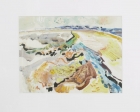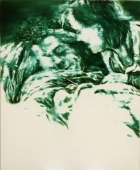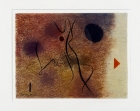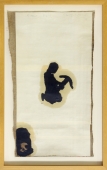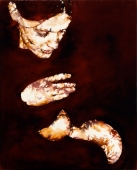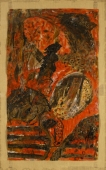Grounding Vision: Waclaw Szpakowski
With works by Guy de Cointet, Hanne Darboven, Trisha Donnelly, Sam Lewitt, Hilary Lloyd, Florian Pumhösl, R. H. Quaytman, and Wac?aw Szpakowski.
Curated by Masha Chlenova and Anya Komar
January 13 — February 19, 2017
Miguel Abreu Gallery
88 Eldridge Street, 4th floor, New York, NY 10002
Wac?aw Szpakowski (1883-1973) was a Polish architect and engineer who created a distinct idiom of abstract drawing, first conceived in notebook sketches in the 1900s and developed systematically in a series of works made with an ink pen on tracing paper between the early 1920s and 1940s. Szpakowski worked in complete isolation, indifferent to the art of his time; yet his project is fundamentally modernist in its aspiration to find the simplest possible means for expressing the underlying order of the universe, one that approaches a scientific investigation in its formal rigor and systematic nature. Calling his works “drawings of linear ideas,” Szpakowski created symmetrical patterns of a continuous geometric line; invariably 1 mm thick and 4 mm apart, it always starts on the left side of the page and ends on the right. For Szpakowski, the line’s relentless trajectory across the surface of each sheet is merely a fragment of its endless rhythmical movement through space and time. He invited viewers to ‘decipher’ what he called ‘the inner content’ of his drawings by following the course of the ‘broken line’ across the surface of the page, “just like one composes the words of a text out of individual letters.”[1] For Szpakowski, the utter simplicity of his creative means and the viewer’s ability to decipher the meaning of his drawings by retracing the process of their making, constituted two essential characteristics that set his works apart from decorative patterns. Szpakowski called for a mode of sustained looking, through which the viewer’s perceptual apparatus would become tuned into the ‘cyclical rhythms of phenomena.’
Seen today, Szpakowski’s work anticipates seriality, accelerated temporalities and the increasing density of visual memory. Resembling circuitries or digitally generated diagrams, the motifs of Szpakowski’s drawings evoke the new technologies of image production that affect perception, heightening the crisis of attention. Exploring the dichotomy of a focused and distracted, decentered gaze, Szpakowski’s project can be understood as a critique of the changing modalities of vision.
This exhibition is the first extensive presentation of Szpakowski’s work in the United States. It brings together twenty- six drawings, made between 1923 and 1943, and his early sketchbooks, alongside works by Guy de Cointet, Hanne Darboven, Trisha Donnelly, Sam Lewitt, Hilary Lloyd, Florian Pumho?sl, and R. H. Quaytman, all of which resonate in important ways with Szpakowski’s project.
Guy de Cointet’s Untitled [7] is one of the artist’s films from the late 1960s depicting hands of a clock imperceptibly moving and covering or uncovering framed numbers, which are positioned horizontally to become illegible. De Cointet made a reference to them in a letter to his brother Paul in 1968: “One idea that might be interesting for an hour and a half is more solid and exciting, after all, than one that is worn out after only ten minutes.”
Like Szpakowski’s “linear ideas,” Hanne Darboven’s Fuchs du hast die Gans gestohlen (1990) demonstrates a serial working strategy, and may also be seen as a mode of abstracted writing, of “inscribing without describing,” without beginning or end. Unlike other conceptual artists of her time, who saw language as a system of meaning, Darboven reduced it to a pure graphic structure. Like Szpakowski, she attempted to systematize non-rationalizable phenomena, but rather than reducing the infinite to simplest forms, she schematized an overabundance of information.
Sam Lewitt’s Weak Local Lineaments (MHTL) (2011) engage directly with the infrastructure of space and energy circuits by using a light source to produce heat. The flexible heating circuit on the ground is a larger version of a Kapton/copper composite heater used to maintain and regulate highly targeted temperatures inside communication devices. Lewitt says: “The work is about a capacity to circulate. It’s a capacity that is based on rationalized standards of visibility that remain invisible. By that I mean global standards that go into planning things like electrical infrastructure. These heating circuits are calculated, planned, and manufactured to bear the load of power that flows through the grid. It’s a standard; anywhere you are in the world, lighting grids are supposed to be isolated.”
In Hilary Lloyd’s Building (2011), two-tiered screens show images of the building bouncing up and down, arranged in grid formations of twenty-one separate frames. Her method of editing can be seen as a spatio-dynamic analog of a drawn line. The vertical and horizontal perspectival axes of the equipment and the mise-en-sce?ne of the display make viewers aware of the directionality of their gaze, while the repetitive, monotonous movement of images produces a sensation of arrested but compulsive attention that suggests today’s dispersed modes of looking.
Florian Pumho?sl made his Study Sequence for Relief 11 and Relief 11 directly in response to Szpakowski’s drawings, taking as their point of departure the beginning or the end of the line in his work. R. H. Quaytman’s Parthian Shot, Chapter 31 (Treblinka), also chosen in direct response to Szpakowski’s “linear ideas,” combines an image taken during the artist’s recent visit to Poland with the optical scrim pattern derived from her earlier chapter.
The exhibition was made possible thanks to the generous loans of the Szpakowski family, the Museum Sztuki in Lodz, Hanne Darboven Stiftung, and Mr Lozowski and the administrative support of the Art and Culture Center in Wroc?aw.
[1] Wac?aw Szpakowski, “Rythmical Lines” [1968] in Waclaw Szpakowski: the Infinity of the Line. (Warsaw: Muzeum Narodowe, 1992), pp.181, 183
Source: Press Release
artist-info.com Exhibition Page
https://www.artist-info.com/exhibition/Miguel-Abreu-Eldridge-Id366328

 Exhibition Announcements
Exhibition Announcements 













